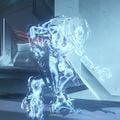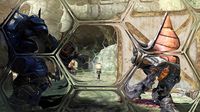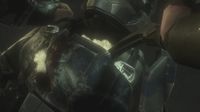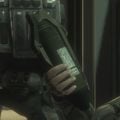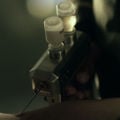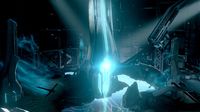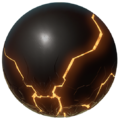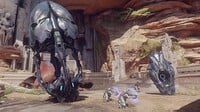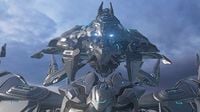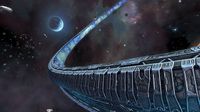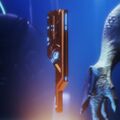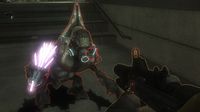Archive:Halo Waypoint/2014 to 2020/Universe/Tech
From Halopedia, the Halo wiki
Active Camouflage
| “ | Active Camouflage is an armor module that allows its user to become nearly invisible for stealth operations. | ” |
T-3 Refraction Dissonance Modifier/Camouflage
Manufacturer: Merchants of Qikost
Usage: Armor Optimization
Length: 2.5in (6.3cm)
Width: 12.1in (30.6cm)
Height: 4.4in (11.3cm)
Summary
Active Camouflage is a refraction dissonance modifier that can bend light around the surface of an individual or structure. It was deemed an essential alien technology early on during the Human-Covenant War, and extensively researched by ONI. Over the course of the conflict, it was wielded impressively by many Sangheili—usually those found in Special Operations or Zealot classes. However, ONI’s breakthroughs here have led to ad hoc compatibility with particular armor and BDU types, the most prominent and notable being that of Mjolnir, as worn by Spartans. When Active Camouflage is equipped, a soldier can effectively pass through an area undetectable save for a slight refractive shimmer while mobile.
History
The Sangheili and the San'Shyuum experimented with various active camouflage systems even before the Writ of Union pooled their knowledge of sensor masking and optical camouflage techniques. While active camo devices eventually incorporated some reverse engineering of Forerunner technology, Covenant devices represent a distinct branch of “baffler” systems.
Artemis Tracking System
| “ | The Artemis Tracking System, or ATS, is a prototype sensor system for use by Spartan soldiers, allowing them to investigate their immediate area for objects of tactical significance. | ” |
VISR Extension
Manufacturer: Ohana Prescient Systems
Usage: Situational Awareness
Firmware Revision: 0.7
Summary
The Artemis Tracking System, or ATS, is an advanced scanning system currently under development for use by Spartan soldiers and ONI operatives. In its current - and unfinished - version, the Artemis highlights enemies and scans the surrounding area for technological artifacts known to be of tactical utility (such as weapon storage crates) or of interest to intelligence analysts.
Provisional access to the ATS has been granted to specific operatives with the permission of Spartan Commander Palmer to aid in the search for missing UNSC assets. Though ONI technicians have approved it for field testing, various bugs and defects limit system functionality outside of a narrow range of approved Mjolnir integrations.
Bubble Shield
| “ | The Bubble Shield is a deployable equipment system that creates a spherical force field when activated. | ” |
Z-4190 Temporal Protective Enfolder/Stationary Shield
Manufacturer: Unknown/Forerunner Origin
Usage: Single Use Dissipative cover
Duration: 20 seconds
Weight: 45.1lbs (20.5kg)
Summary
The Bubble Shield is a ‘dissipative’-style deployable shield system of Forerunner origin, used by Warrior-Servants to create temporary fortifications using a sphere of interlocking hexagonal force enfolder elements. A crude (by Forerunner standards) copy of the technology was later employed by the Covenant, based (ironically) on captured ONI prototypes recovered after the fall of Reach.
Due to its size, mass, and relatively short power cell duration, along with low rates of production, the Bubble Shield saw limited use during the latter days of the Covenant War. ONI itself manufactured a small number of the devices until 2555, when it refocused its shield research efforts towards Mjolnir-compatible emitters.
Biofoam
| “ | Biofoam is an analgesic and antiseptic foaming polymer compound used by soldiers and medics to seal and disinfect deep wounds. It is a standard component of all UNSC first-aid kits. | ” |
Hemostatic Medical Polymer
Legal Status: OTC (UEG)
Drug Class: Morphophetamine
Delivery: Canister, Medical Biofoam
Application: Single use canister
Delivery
Biofoam is supplied in single-use canisters of varying size, prefilled with an expansion agent and liquid polyethyltriphosphate. When the two mix and are exposed to air they immediately produce a foaming reaction. The foam strongly adheres to tissues while also releasing encapsulated medical compounds that promote clotting, disinfects the wound, and numbs pain. After a short time the foam will set, becoming a semirigid porous mass internally, while forming a hardened skin on those areas exposed to air.
Possible Side Effects
In extremely rare cases, edema - caused by excess fluid trapped in the body's tissues - and allergic reactions have been documented.
Cytoprethaline
| “ | Cytoprethaline is used in the process of cryogenic storage for preventing damage to cell membranes and ensuring healthy and safe transportation across space. | ” |
Prescription Medication
Legal status: Rx-only (UEG)
Drug class: Cellular Anticrystalline
Delivery: Syringe
Routes: Subcutaneous
Summary
Cryostorage apparatuses such as cryotubes (or “cryochambers”) are stasis compartments found within human space-faring vessels that allow passengers to endure protracted journeys while preserved at sub-zero temperatures. In order to prevent damage to cell membranes due to the formation of ice crystals, a chemical called cytoprethaline is injected into subjects before they are sealed into the chamber and enter hibernation. This is a vital step in order to ensure healthy and safe transportation across space. Although cytoprethaline has become a standard part of 26th-century interstellar life, it is not without its risks. One such danger is the opportunity for chemical allergies, which can see suffering subjects endure debilitating health after awaking from sleep. One particularly notable case was Thomas Lasky, who suffered allergic reactions to such severity that he was offered a medical discharge.
Possible Side effects
Allergic reaction: Blistering, peeling, or red skin rashes. Itching or hives, swelling of face, hands, or feet. Swelling or tingling in throat or mouth. Trouble breathing, shortness of breath, chest tightness, cold sweat, and bluish-colored skin. Sudden or severe headache, dizziness, problems with speech or walking.
Composer
| “ | The Composer is a Forerunner device used to reduce a living being into a collection of data – referred to as an "essence" by Forerunners. | ” |
Forerunner Sublimation Device
Affiliation: Forerunner
Manufacturer: Builder Rate
Usage: Sublimation Device
Length: 126.7ft (38.6m)
Width: 94.2ft (28.7m)
Height: 681ft (207.6m)
Summary
The Composer is a Forerunner device used to transform or ‘compose’ a sentient being into a collection of data through a painful and irreversible process charitably called ‘sublimation’. The data –referred to as an ‘essence’ by Forerunners – could then transferred into machine storage for safekeeping or later interrogation and analysis. The Didact would use this device to make his Promethean warriors immune to the Flood by combining their composed essences with specialized Forerunner combat constructs to create the Promethean Knights. Later, he would also harvest human essences to create larger numbers of Knights that could be enthralled to his service.
Technology
The Composer is one of the few non-Precursor devices that exploit neural physics, the peculiar science of that most ancient of species which defied Forerunner understanding, even after millions of years of study. The high-energy fields of entangled sympathies emitted by the Composer envelop any living being with a sufficient complexity to resonate with the device. The Composer breaks down their bodies into digital templates in a manner that eluded the full understanding of even its creators. The resulting imprints, or essences, were remarkably similar to high-level ancilla, and stored mentalities could even be given consciousness by emulating their original biological neural structure.
Cryptum
| “ | A Cryptum is a Forerunner stasis/containment machine used to safely preserve beings in a state of meditation for incredibly long periods of time. | ” |
Warrior Keep
Affiliation: Forerunner
Manufacturer: Unknown/Forerunner Origin
Usage: Stasis Hold
Length: 282.4ft (86.1m)
Width: 282.5ft (86.1m)
Height: 281.7ft (85.9m)
Summary
Often referred to as a “Warrior Keep,” a Cryptum is a Forerunner apparatus that sustains and protects a physical being, while they are in a deep state of meditation referred to as “xankara.” This state can be maintained for many millennia, effectively locking away the being in an immobile and inert state. During their time in the galaxy, Forerunners used this form of exile for most of their rates, when other punishments were deemed too severe. The most notable usage was with Prometheans (hence the name “Warrior Keep”), and, in particular, the renowned and formidable Didact.
Covenant Drop Pods
| “ | The Covenant drop pod is the quickest and most efficient troop deployment method, though it comes with extreme risk. | ” |
T-55 Individual Breaching Carapace
Manufacturer: Lodam Armory
First Observed: 2554
Crew: 1 Operator
Summary
Covenant drop pods are designed to deploy troops from a capital ship to positions behind enemy forces or at key choke points, in an effort to dynamically modify combat or strategically gain the upper hand. Drop pods vary in size and shape, though they generally provide conveyance for a 1-4 personnel, distributing individual soldiers or small groups directly into a combat area.
Function
Drop pods are fired from a capital ship or localized deployment, typically from an orbital or suborbital position. Launching toward the surface as a means to circumvent enemy movement or sever supply lines, the pods breach the atmosphere (if necessary) and close in on the target area before forward thrusters are activated, braking the craft just before impact. The effect is typically disorienting for the enemy, allowing pods to violently strike the target, immediately ejecting troops before the opposition can recover from the event.
Variants
T-55 Individual Breaching Carapace (IBC): Bearing only a slight resemblance to the sleek drop pods used during the Covenant’s primacy, the T-55 IBC is emblematic of the classic Sangheili design. Aerodynamically streamlined for speed and maneuverability, this variant has seen frequent use in the protracted feud between Sangheili clans, primarily due to the conflict’s wildly territorial nature. Manufacturing cost and deployment methodology, however, has restricted single-personnel drop pods to Sangheili warriors alone.
T-55 Squad Breaching Carapace (SBC): Distinct from other squad deployment craft, the T-55 SBC has four bays and is capable of deploying up to the same number of Covenant personnel. Unlike the IBC, which requires the operator to lay against a gravity stabilizer for protection, the SBC deploys personnel standing upright, locking them into place with gravity-based floor anchors. Upon impact, the carapace’s doors slide open and the anchors are released, immediately deploying the troops.
Guardian
| “ | Guardians are powerful security constructs created by the Forerunners to enforce the tenets of the Mantle for the greater good of the galaxy. | ” |
Protectors of the Mantle
Affiliation: Forerunners
Manufacturer: Unknown
Usage: Security and Enforcement
Height: 4,635 Ft (1,412 Meters)
Origin
The Mantle of Responsibility was the predominant philosophical system adhered to by the Forerunners, guiding and informing governance of the entire galaxy based on the belief that the most developed species was charged with the stewardship of all life. The tenets of the Mantle, however, allowed for competition and conflict as long as it did not threaten galactic biodiversity. Since such threats existed, the Forerunners designed Guardians to police lesser star systems and enforce the Mantle’s edicts on noncompliant or overly-bellicose species.
Function
Guardians had numerous roles and functions in service of the Mantle, but the primary one was the monitoring and subjugation of all local power networks. If necessary, Guardians could instantaneously neutralize these networks through a series of debilitating attenuation pulses. The deployment of multiple Guardians allowed the constructs to strategically coordinate their strike, rendering all but the most sophisticated foe completely inefficacious. This method of control was largely unchallenged.
History
Guardians were developed and deployed many millennia before the Flood appeared, and were just one of the tools that the Forerunners used to ensure their power and influence in the galaxy. Utilized throughout Forerunner history to audit any potentially belligerent sentients, Guardians could swiftly quash revolts or be deployed in advance as an imposing threat of force, but they were useless against the rise the parasite. Before activating Halo as a final defense, the Forerunners buried remaining Guardians on isolated shelter worlds, where they would remain dormant until called upon to serve the Mantle once again.
Emergence
In October 2558, Guardians began emerging on the shelter worlds, a hundred thousand years after they had been abandoned. Their awakening a sign the Mantle has been reclaimed and that the Domain once again blazes with knowledge and purpose.
Halo Array
| “ | The Halo Array is a series of ringworlds created by the Forerunners for the purpose of destroying the horrific extragalactic parasite known as the Flood. | ” |
Weapons of Last Resort
Installation 03: Gamma Halo
Installation 04: Alpha Halo
Installation 05: Delta Halo
Installation 07: Zeta Halo
Summary
One hundred millennia ago, the Forerunners designed an array of ringworlds, collectively called Halo, to destroy the merciless Flood. The Halo Array was the focus of the Covenant faith for thousands of years. It eventually led to the culmination of long hidden Forerunner plans for humanity to reclaim their role as caretakers of the galaxy.
The Halos were massive ringworld weapons, their interior surface capable of providing sanctuary for a broad range of life. Initially, twelve rings were created by Builders at the greater Ark, but their size and effectiveness were soon questioned when they began to accrue enormous temporal reconciliation debts and could not be moved easily. Not long after this, the Forerunners designed yet another Ark, one much smaller, distributing seven equally sized rings which would become the extant Halo Array. The Forerunners ultimately fired these rings in an effort to purge the galaxy of the Flood. However, the rings also contained dormant specimens of the parasite in the hope that if it were to ever return, a cure could be found to prevent its spread.
Janus Key
| “ | The Janus Key is a Forerunner device which acts as an activation catalyst for a galaxy-spanning Cartographer within a site called the Absolute Record. | ” |
Forerunner Cartographer
Manufacturer: Unknown/Forerunner Origin
Half Key Length: 5.5in (14cm)
Half Key Width: 1.2in (3cm)
Half Key Height: 1.4in (3.5cm)
Usage: Galactic Cartographer
Full Key Length: 5.6in (14.2cm)
Full Key Width: 1.2in (3cm)
Full Key Height: 1.9in (4.9cm)
Summary
Long hidden on the shield world of Requiem, the Janus Key is a Forerunner artifact of extraordinary importance. It remained concealed until it was discovered by Spartan teams deployed to counter Covenant excavation sites. According to the Librarian, this artifact was intended to provide real-time locational data to all Forerunner technologies, giving the holder incredible power upon bringing the key to the location referred to as the Absolute Record.
MJOLNIR
| “ | The brainchild of Dr. Halsey, MJOLNIR powered assault armor is has become the legendary combat counterpart to the Spartan program. | ” |
Powered Assault Armor
Manufacturer: Materials Group
Location: Damascus, Vhalkem - CHI CETI IV
Testing Site: Damascus Testing Facility
SUMMARY
The brainchild of Dr. Catherine Halsey, Project: MJOLNIR was a revolutionary powered armor system envisioned as the counterpart to the SPARTAN program. When perfected, Mjolnir armor would enhance the combat abilities of the Spartan super-soldiers far beyond what their physiological augmentations were already capable of. Throughout its decades of development and refinement, Mjolnir became more than just a suit of armor, it became a symbol of humanity’s ingenuity, adaptability, and fortitude in the face of impossible odds.
PROTOTYES
Three generations of combat exoskeletons preceded Dr. Halsey’s work. The Mark I battle suit was the UNSC’s first attempt at creating powered exoskeletons, though it remained a tethered testing platform during the entire span of its development. Mark II armor was similar to the Mark I, with incremental improvements in mobility and ease of use. Mk. III was the first battle suit to successfully operate without a tether, though the suit had to stay within range of a bulky, immobile broadcast power generator.
GENERATION ONE [GEN1]
GEN1 Mjolnir armor is characterized by highly idiosyncratic permutations and high degree of personalization and performance tuning for each Spartan super-soldier.
MK.IV
The Mark IV ushered in a new era for military technology, and served as the basis for all proceeding MJOLNIR designs. It pioneered a compact fusion reactor that allowed for enhanced speed and strength, advanced neural interface controls, and the latest in composite armor technology. Coupled with the physical augmentations and reaction times of SPARTAN-II super-soldiers it proved to be a game-changer in the war against the Covenant. Upgrades and permutations of the Mark IV remained in use until after the Covenant War.
MK.V
Considered an interim design by many, the Mk. V armor featured a more powerful fusion reactor, which allowed for the incorporation of energy shields, a feature that would prove vital to Spartan survivability. The Mk. V platform also allowed for the housing of a Smart AI within the suit’s microframe, meaning that the user could combine enhanced reflexes and strength with a unrivaled access to battlefield networks and real-time intelligence assessments.
MK.VI
Mark VI contained upgrades to nearly every aspect of the previous Mk. V version. Improvements were made to the armor’s shielding against plasma-based weaponry, and a biofoam injector was added, increasing the chances for a wearer to survive more serious injury without immediate or external medical attention. In addition to these improvements, Mk.VI also introduced further mission-specific permutation packages, as well as upgrades to system reliability, redundancy, and ease of repair.
MK.VII
Loosely conceptualized by Dr. Halsey as early as 2535 CE, the Mk. VII never saw full production due to its complexity and expense. The Mk.VII featured limited energy shield shaping and an advanced nanotechnology repair suite. Ultimately, the UNSC determined that continuing to iterate on the SPARTAN-II focused GEN1 platform would see significantly diminishing returns, particularly in light of escalating costs and capabilities of the new SPARTAN-III and SPARTAN-IV personnel.
GENERATION TWO [GEN2]
Generation 2 Mjolnir production uses a spiral-development model, allowing the UNSC and its various corporate partners to iterate and evolve armor systems much faster and more efficiently than before. Primarily developed for the newer SPARTAN-IV program, GEN2 Mjolnir focus on integrating the vast majority of the armor’s vital hardware systems within the inner techsuit itself, allowing for more streamlined production and easier implementation of specialized subsystems and armatures.
Promethean Crawler
| “ | Promethean Crawlers are low-grade, quadruped constructs created by the Forerunners. | ” |
Forerunner Construct
Affiliation: Forerunner
Type: Promethean Construct
Length Range: 6ft 8in – 7ft 8in (204.2 – 234.7cm)
Weight Range: 347 - 371 lbs (157.4 - 168.3 kg)
Summary
Promethean Crawlers are low-grade, quadruped constructs created by the Forerunners. The accepted theory is that their original use was as the initial deployment into Flood strongholds. After weakening the parasite’s numbers, the Forerunner commander known as the Didact could then send in more valuable assets. The UNSC first encountered Promethean Crawlers in 2557, after both the UNSC Forward Unto Dawn and UNSC Infinity crash-landed inside the Forerunner shield world of Requiem. Like most Promethean constructs, the Crawlers have multiple variations that fill different roles in combat.
Crawler
Without question, the standard Crawler was the most prominent defensive element on Requiem. These aggressive hunters operate in groups or packs that quickly engulf their adversaries in overwhelming numbers. To make matters worse, Crawlers can target enemies both near and far with their embedded boltshot armament, and are even capable of vertically scaling structures to gain tactical advantage.
Crawler Snipe
The Crawler Snipe is a specialized class of Promethean Crawler. It is larger than the standard Crawler and equipped with distinctly shaped armor, ultimately focusing on long-range combat and reconnaissance. The Crawler Snipe’s most notable skill is its impressive ability to kill targets from extreme distances with an imminently mounted Forerunner binary weapon technology. This weapon can strike down enemies at significant range, disintegrating them with a single shot. From vantage points high above the battlefield, Crawler Snipes can reduce enemy numbers with unbelievable accuracy and devastating results.
Alpha Crawler
The Alpha Crawler is the most powerful class of Promethean Crawler. The series of large hard light spikes which line its head and back allow for easy identification of this formidable foe. They act as pack leaders, guiding Crawler detachments of varying sizes into battle. It is important to note that Alpha Crawlers are not always found in Crawler packs, and occasionally appear in numbers greater than three or four per pack. However, no matter their quantities, Alpha Crawlers always serve the same purpose: lead, augment, and fortify localized Crawler forces. With embedded Forerunner suppressor weaponry, they maintain a safe distance while unleashing a barrage of firepower on their targets.
Promethean Watcher
| “ | Promethean Watchers act primarily as defensive drones, taking on a tactical support role. | ” |
Forerunner Construct
Affiliation: Forerunner
Type: Promethean Construct
Height: 4ft 2in (127cm)
Weight: 318 lbs (144.2kg)
Summary
Forerunner Warrior-Servants designed the Promethean Watchers to act primarily as defensive drones, taking on a tactical support role. Controlled by a low-level ancilla, Watchers are initially held within the armored shell of a Promethean Knight. During combat, they emerge and aid Knights, utilizing hard light energy shielding to protect its allies, as well as actively reconstituting fallen allies. While their primary operation is defensive, they have been known to function offensively, raining down fire on enemies with their mounted boltshot. The UNSC first encountered Promethean Watchers in 2557, on the Forerunner shield world of Requiem.
Promethean Knight
| “ | Promethean Knights are a series of heavily armored, powerful biped machines operated by sentient essences cultivated via the Composer. | ” |
Forerunner Construct
Affiliation: Forerunner
Type: Promethean Construct
Height Range: 9ft 11in–12ft 2in (302.3–367.7cm)
Weight Range: 898–934lbs (407.3–423.7kg)
Summary
An elite sect within the rate of Warrior-Servant, the Prometheans were an incredibly skilled class of combatants who fought successfully in many conflicts across Forerunner history. Approximately 10,000 years before the activation of Halo, the Prometheans were a critical force during the war against the humans, but the political struggles afterward forced them into exile. Thousands of years later the parasite returned and the Prometheans were revived to make war against it. Though they suffered tremendous casualties, the worse came at their own hands.
Although the Composer could not return a living essence into an organic body, the essence could be incorporated into a machine and so began the Prometheans’ final strategy against the Flood. In full agreement, the Prometheans pledged to be composed and integrated into powerful war machines, following the Ur-Didact into war. Although this strategy worked incredibly well, there were not enough Prometheans to bring victory. Not deterred, the Ur-Didact refreshed his forces with protected human essences, putting him at odds with the Forerunners and eventually sealing his fate at the hands of his wife.
Although the original Prometheans may have ended during the Forerunners’ war with the Flood, the Promethean forces found by UNSC forces on Requiem are still a very real embodiment of that same ancient, formidable role. These vicious mechanized warriors carry in them the composed essences of humans, single-mindedly tasked with the security of any Forerunner strongholds they’ve been left to guard. The Promethean Knights thus far encountered by the UNSC have a heavy, well-armored torso, resting atop a pair of stalking legs. Its primary arms are mounted with heavy weapons, bearing smaller manipulating appendages tucked below a tightly caged head. While currently the UNSC has recorded encounters with four specific variations of Promethean Knight, it can be inferred that there might potentially be further variations designed to full more specialized roles.
Knight
Designed and literally molded into existence by the Didact, Promethean Knights represent his final effort at destroying the Flood and preventing the firing of the Halo Array. These ancient and mighty warriors are not autonomous drones like Sentinels or even Crawlers, but are driven by the roiling vestiges of human essences composed during the last days of Forerunner history. Although their presence would not prevent the firing of Halo, they were tasked with guarding high-value Forerunner strongholds until the Didact was released.
Knight Lancer
Knight Lancers generally function as scouts and snipers, representing a critical component in the Didact’s Promethean stratagem of Flood containment and cauterization. Lancers are fully capable of engaging in close-quarters combat like other Promethean classes. However, they are explicitly designed to secure elevated positions from which they can survey the battlefield, unleashing remarkably accurate and lethal fire from massive ranges. Additionally, Lancers can activate a hovering drone called the Autosentry—a powerful tool that provides stationary yet versatile covering fire, tenaciously unleashing damage on any enemies.
Knight Commander
Knight Commanders form the primary leadership of all Promethean Knight detachments, though this is a less rigid structuring based not on rate or experience, but rather on a strategic necessity. Commanders are outfitted with impressively heavy armor and wield a powerful Forerunner weapon known as the Incineration Cannon—they are often deployed where substantial hostile forces exist. Knight Commanders are remarkable tacticians, but their use of incredible firepower, drone sentries, and enhanced vision make them formidable against large numbers of infantry, powerful weapon emplacements, or even heavy vehicles.
Knight Battlewagon
Arguably the most dangerous and unpredictable of Promethean Knights, the Knight Battlewagons are an incredibly dominant force, created for close-quarters combat. Their hulking frames are covered in dense, resilient armor laced with fanned barbs of hard light. As their name portends, the Knight Battlewagon is more of a walking weapon than an individual combatant. It is incredibly fierce in wielding the Prometheans’ classic Scattershot weapon as previously used during their war with the Flood. They are extraordinarily lethal and have been known to single-handedly lay siege to even the most heavily fortified of sites.
Soldier
| “ | Soldiers are Armiger-class bipedal combat platforms developed and employed by the Forerunners. These war-machines proved incredibly useful for raiding ancient human warships and combating the Flood. | ” |
Armiger Combat Platform
Affiliation: Forerunner
Type: Combat Construct
Summary
During their war with ancient humanity millennia ago, the Didact employed the use of Armigers – bipedal combat platforms that proved incredibly useful for raiding ancient human warships, particularly when attempting to infiltrate the often more confined spaces of human vessels.
Following the conflict, after the Didact had entered into exile during the ecumene Council’s diminishment of his rate, the Forerunners found themselves dangerously underprepared for the Flood’s return. In order to bolster the empire’s defenses, the Master Builder recommissioned the production of the Armigers to support the ranks of both Builder Security and the waning number of remaining Warrior-Servants. The Soldiers are one such example of these combat platforms, with multiple types used by various factions within the Forerunner ecumene.
While most were originally expended in the fruitless war against the Flood or compromised by the logic plague, some were secretly left to guard key Forerunner sites in the ages following the firing of the Array. Their reappearance with the Guardians indicates the secret of their manufacture has once again been uncovered, and as humanity continues to try and reclaim the vestiges of the Forerunners’ dominance, the reawakening of these constructs and others like them cannot be taken lightly by the UNSC.
UNSC Jet Pack
| “ | The Jet Pack is an apparatus that provides limited flight capability in a gravity well and full maneuver control in microgravity operations. | ” |
Series 12 Single Operator Lift Apparatus
Manufacturer: Lethbridge Industrial
Usage: Armor Optimization
Length: 9.6 in (24.3 cm)
Height: 21 in (53.1 cm)
Width: 16.2 in (41.2 cm)
SUMMARY
All Navy and Marine Corp combat elements receive familiarization with jet packs for use in microgravity (e.g. when artificial gravity fails or while conducting boarding actions). However, only Spartans and particular commando units – such as ODST and Delta-Six operators – receive additional training on how to use the thruster units in an atmosphere. This is typically denoted as “jump pack training” despite the equipment commonality. Safety considerations are of paramount importance during this training, particularly for unaugmented personnel, who – unburdened by a half-ton of power armor – can easily misjudge the height and speed they can attain.
Though the next spiral of GEN2 Mjolnir refinements will incorporate an integrated set of thrusters, full maneuvering capabilities will continue to require a dedicated thruster pack. The standard post-war unit is Lethbridge’s Series 12 Single Operator Lift Apparatus (SOLA), which features integrated fly-by-light controls, seamless Mjolnir integration, and harness linkages for all current combat armor and techsuits.
UNSC Drop Pods
| “ | The drop pod is a means of troop deployment from very high altitudes or, in most cases, from space. This equipment is most frequently employed by Orbital Drop Shock Troopers (ODST). | ” |
Single-Occupant Exoatmospheric Insertion Vessel
Manufacturer: Ushuaia Armory
Entered Service: 2461
Crew: 1 Operator
Length: 7.7ft (2.3m)
Width: 8.7ft (2.7m)
Height: 16.4ft (5m)
Weight: 1,100lbs (499kg)
Summary
The Single-Occupant Exoatmospheric Insertion Vehicle (SOEIV), commonly referred to as a drop pod, is a class of Human Entry Vehicle (HEV). Drop Pods are an extraordinary means to deploy soldiers through an atmosphere and onto a world’s surface. Instead of using traditional dropships, ODSTs are released in individual pods, which gives a soldier more maneuverability and creates less of a target for the enemy. Despite the obvious danger inherent in SOEIV deployment, these drops actually have a lower overall attrition rate in combat than conventional dropship deployment. This is primarily due to the fact that each soldier is being conveyed separately instead of together in one craft.
Another major advantage to SOEIVs over traditional dropships is that a spacecraft can make a fast pass over a planet and deploy hundreds of soldiers in quick succession. This means that the ship is capable of evasive maneuvers, limiting its vulnerability to attack. Once a successful drop has been achieved, the hatch is expelled by way of an explosive gas-bolt system triggered by the occupant. While this sort of deployment has been refined over time, many drops can still end unsuccessfully due to equipment malfunction or user error.
Design
Within a standard SOEIV is a crash seat with secured belts, controls for maneuvering the pod, and communications systems which allow synchronization with others during deployment. An SOEIV’s size can vary dramatically from pod to pod. An SOEIV pod is a blunt carriage, which has a single entry hatch on one side. Inside is a crash seat, a harness, and several weapons racks and lockers. Much of the interior is taken over by equipment so, in spite of the pod’s size, there is not much room to move. The blunt pod ironically resembles a large iron coffin and is one reason the vehicles have a number of rather grim nicknames. The back of the pod is entirely sealed off and the front typically, though not exclusively, includes a variety of windows and a gas-bolt–operated hatch system.
Function
Drop pods are typically deployed from high altitude or from an exoatmospheric location, being fired or soft-ejected toward the planet's surface until the atmosphere is breached. At this point, the occupant is free-falling at terminal velocity until the pod's automated braking-chute system is initiated, thrusting the pod backward prior to landfall. The top-mounted braking chute system itself is an extended cable attached to four petal-like flaps which automatically activate at low altitude, reducing the pod’s momentum. The combined efforts of reverse thrusters and airfoils slow the craft enough to ensure that impact is not (usually) fatal.
POST-WAR PATTERN
In the years following the human-Covenant war, the UNSC partnered with experienced military contractors to make a number of improvements to the drop pod platform. Advancements and improvements include (but are not limited to) more reliable in-flight communications, more powerful maneuver thrusters and limited inertial compensation, a new air brake design, significantly improved structural integrity with the incorporation of new metal matrix composites, and thermal superconducting elements incorporated into the composite heatshield. The internal harness of all post-war drop pods is also highly configurable, with hookups and system interlinks compatible with the latest ODST battledress and Spartan Mjolnir variants.
VISR
| “ | VISR is a data management suite used by ODST and Spartan super-soldiers to enhance their situational awareness on the battlefield. | ” |
Visual Intelligence System, Reconnaissance
Manufacturer: Varies
Usage: Situational Awareness
Firmware Revision: 4.0
Summary
Visual Intelligence System, Reconnaissance (VISR) is a collection of augmented reality and sensor fusion systems that selectively filters and optimizes the soldier’s view of the battlefield. In addition, it integrates smart-link targeting feeds and Identify Friend or Foe (IFF) synchronization with UNSC battlenets.

